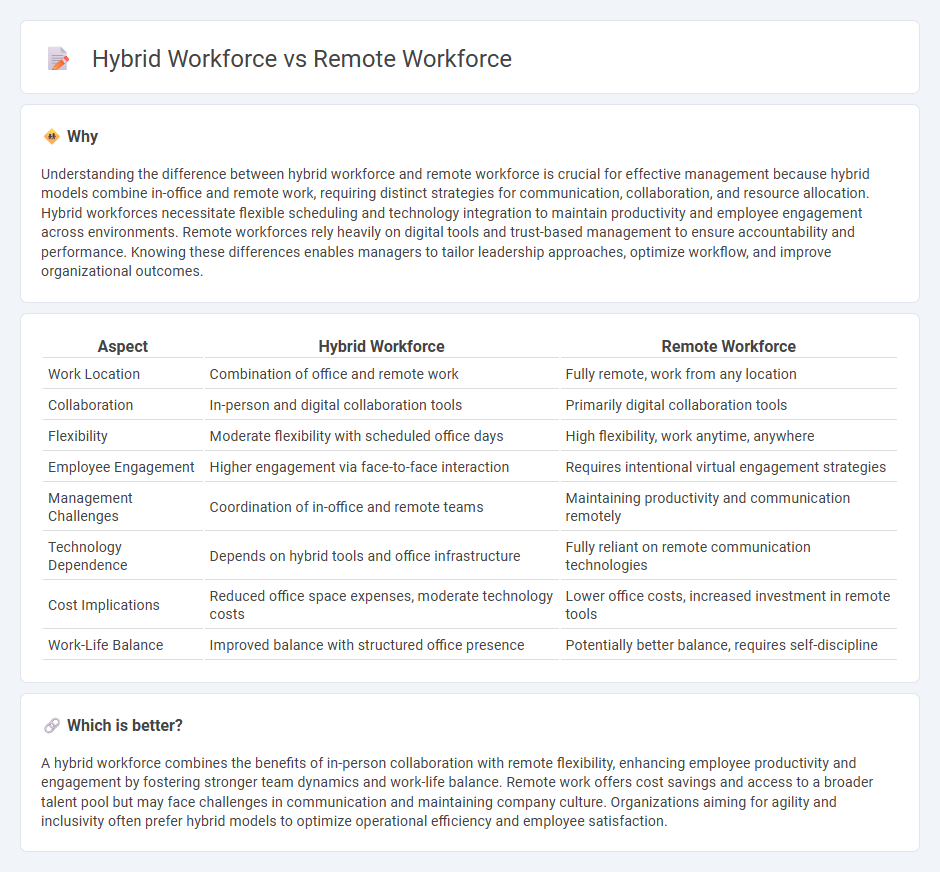
Hybrid workforce models combine in-office and remote work, offering flexibility while maintaining face-to-face collaboration, crucial for enhanced team dynamics and productivity. Remote workforces operate entirely off-site, leveraging digital tools for communication and project management, which often reduces overhead costs and broadens talent pools. Explore strategies to optimize both hybrid and remote workforce management for sustainable organizational success.
Why it is important
Understanding the difference between hybrid workforce and remote workforce is crucial for effective management because hybrid models combine in-office and remote work, requiring distinct strategies for communication, collaboration, and resource allocation. Hybrid workforces necessitate flexible scheduling and technology integration to maintain productivity and employee engagement across environments. Remote workforces rely heavily on digital tools and trust-based management to ensure accountability and performance. Knowing these differences enables managers to tailor leadership approaches, optimize workflow, and improve organizational outcomes.
Comparison Table
| Aspect | Hybrid Workforce | Remote Workforce |
|---|---|---|
| Work Location | Combination of office and remote work | Fully remote, work from any location |
| Collaboration | In-person and digital collaboration tools | Primarily digital collaboration tools |
| Flexibility | Moderate flexibility with scheduled office days | High flexibility, work anytime, anywhere |
| Employee Engagement | Higher engagement via face-to-face interaction | Requires intentional virtual engagement strategies |
| Management Challenges | Coordination of in-office and remote teams | Maintaining productivity and communication remotely |
| Technology Dependence | Depends on hybrid tools and office infrastructure | Fully reliant on remote communication technologies |
| Cost Implications | Reduced office space expenses, moderate technology costs | Lower office costs, increased investment in remote tools |
| Work-Life Balance | Improved balance with structured office presence | Potentially better balance, requires self-discipline |
Which is better?
A hybrid workforce combines the benefits of in-person collaboration with remote flexibility, enhancing employee productivity and engagement by fostering stronger team dynamics and work-life balance. Remote work offers cost savings and access to a broader talent pool but may face challenges in communication and maintaining company culture. Organizations aiming for agility and inclusivity often prefer hybrid models to optimize operational efficiency and employee satisfaction.
Connection
Hybrid workforce models seamlessly integrate remote and on-site employees, enhancing flexibility and productivity within management strategies. Effective management leverages digital collaboration tools and performance tracking to unite hybrid and remote teams, ensuring alignment with organizational goals. This connection boosts employee engagement, reduces operational costs, and supports dynamic workforce allocation.
Key Terms
Communication Tools
Remote workforce relies heavily on cloud-based communication tools like Zoom, Slack, and Microsoft Teams to ensure seamless collaboration across diverse locations. Hybrid workforce combines in-person meetings with digital platforms, requiring integration of tools that support both face-to-face and virtual interactions effectively. Explore our detailed analysis to understand the best communication tools tailored for your workforce model.
Flexibility
Remote workforce offers unparalleled flexibility by enabling employees to work from any location, reducing commute times and promoting work-life balance. Hybrid workforce combines remote and on-site work, providing flexible scheduling while maintaining in-person collaboration and team cohesion. Explore the benefits and challenges of flexibility in remote and hybrid work models to optimize your organization's approach.
Employee Engagement
Remote workforce models often face challenges in maintaining consistent employee engagement due to limited face-to-face interactions and potential feelings of isolation. Hybrid workforce strategies enhance engagement by combining in-person collaboration with remote flexibility, fostering stronger team connections and inclusion. Explore more to understand how tailored engagement techniques improve productivity in both workforce types.
Source and External Links
Remote Workforce: Why It Matters and How To Manage One - A remote workforce consists of employees who work from home or another off-site location instead of a central office, enabled by advances in communication and productivity technology for flexible work arrangements.
What is a Remote Workforce? - A remote workforce refers to employees who perform all essential job duties from locations outside a traditional office, with productivity and engagement often higher than in-office counterparts due to reduced commute times and greater control over their work environment.
Remote Workforce Management: The Guide to Success - Remote workforce management involves overseeing employees working from various locations, requiring effective communication, clear processes, and the right technology to maintain productivity and accommodate flexible schedules.
 dowidth.com
dowidth.com